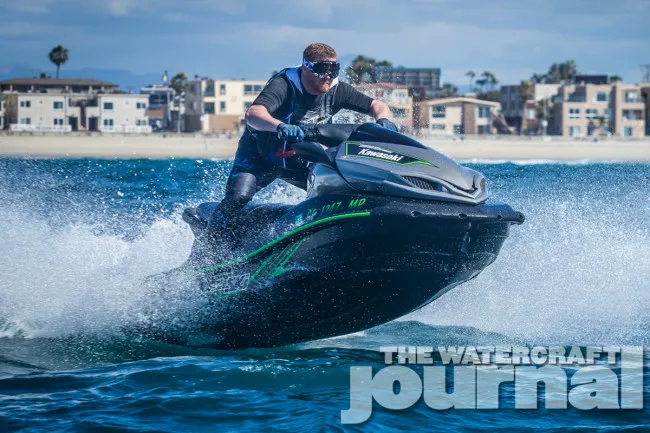It started in 2007 with the 250-horsepower Kawsaki Ultra 250X. The next year, when rivaled by Sea-Doo’s ’08 255HP X-series, Kawasaki raised the bar to 260. Sea-Doo matched in 2009. Within a year, the Ultra was now a 300X and wielded improved handling on the closed course as much as in the open ocean. And, looking to improve internal engine temperature management and increased combustion efficiency, the 310X was born in 2014.
As much as you might like the different takes on Kawasaki’s Ultra JetSki – nothing beats the original. In these pages you’ll find reports on the 310R, the 310X Special Edition and the top-of-the-heap 310LX, and you’ll find praise for each of them in their own right. But at their core, and what ultimately attracts performance enthusiasts is the straight-laced, bare-knuckled street fighter, the 2015 Kawasaki Ultra 310X JetSki.
Strip away the luscious burnt orange hue of the Special Edition, the racy motocross-inspired handlebars and narrowed seat of the 310R, or the over-the-top Jetsound system (with in-dash radio controls) and heat-resistant bolstered seat of the 310LX, and you’re left with the 310X, which in our experience, is what people really want anyways. Of course, what can be said of the Kawasaki Ultra JetSki that hasn’t already been said? Give us a minute…
From the outside, the Ultra 310X is handsome in its simplicity. There’s nothing super busy about it. No complex angles, chrome louvers or business to confuse it with a Michael Bay production. Twin snouts are angrily flared, as the hood’s curves flow up and over the fairings into a low and broad saddle and back up into a pointed rear grip. The footwells are wide and deep, the rear tray spacious. The Ebony and Metallic Phantom Silver livery touched with highlights of iconic Kawasaki Green.
Beneath the front bonnet and within the glove box is a cavernous 56 gallons of combined storage, as well as a removable weather-sealed bin. Tilt steering offers five different riding postures, the highest and the lowest ideal for extreme positions for offshore and closed course, respectively. A spring-loaded retractable swimstep leads to thick Hydro-Turf traction matting on the deck, with a lower and higher handgrips for easy boarding. A tow-eye is also found beneath the stern handrail.
Ergonomically, the bench is wider than many craft considered its competition with only slight contouring. Newly redesigned rearview mirrors and a pistol-like grip of the left-hand reverse lever are nice touches, although the absence of a handlebar-mounted brake and reverse lever is all the more amplified now with Yamaha’s RiDE system (new for 2015) following Sea-Doo’s lead with iBR in 2009. It’s certain Kawasaki engineers have likely drawn up their own version of the technology that far surpasses anything we could imagine.
The dashboard’s LCD screen fans out nicely and allows for easy reading of instrumentation while at speed all while mitigating glare. The handlebars now feature up and down toggles for Cruise Control, electronic trim and Kawasaki’s own take on ECO mode.
We did find ECO mode to be the most aggressive of all three brands’ fuel-saving tunes, capping the 310X’s powerband to low 60’s mph, rather than say, Sea-Doo’s that restricts their craft deep into the 40’s. For true fuel savings, we found the use of Kawasaki’s yellow “Learner Key” to be far more successful in reigning in the Ultra’s bridle.
Beneath the seat though, is where the 310X truly starts to get interesting. Currently, the second-largest displacement 4-stroke in the industry (1,498cc) delivers by far, the most horsepower of any personal watercraft available, spooled by an Eaton Twin Vortices Series (TVS) roots-style supercharger (with air-to-water intercooler) producing an impressive 16.8 psi.
The dual overhead camshaft (DOHC), four valves per cylinder, inline four-cylinder presses all that boost past 8.2:1 compression pistons through a direct-drive coupler to a massive axial-flow, single stage 160mm jet pump, spinning a three-blade, oval-edge stainless steel impeller to produce 1,890 lbs. of thrust. If that sounds impressive, it is. But it’s also not cheap.
Even with the use of advanced Digital Fuel Injection (DFI) with intelligent engine mapping, the big Ultra is thirsty, and that 20.6 gallon tank of 91 octane can vanish quickly if the 60mm throttle body is left wide open. Even casual play with plenty of hot dogging emptied three quarters of the tank by lunchtime. What’s the old saying go? You gotta pay to play…
Make no bones about it, there is nothing gentle about the Kawasaki 310X – or those that share its powertain. It comes on hard, and we mean it. To our knowledge, this craft has racked up more championships in its bone stock form than any of its contemporaries. That alone should speak volumes. And to reiterate previous evaluations, we have yet to encounter a runabout to manage rough water or the open seas as aptly as the Kawasaki Ultra.
Personally, we doubt we’ll see much in the way of changes for the 310X in the next few years. And rightfully so. Kawasaki has persistently raised the bar of performance, and we can’t imagine them changing that philosophy. The Ultra 310X is a brute, and Kawasaki meant it that way.






























